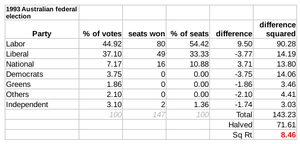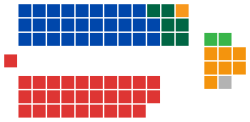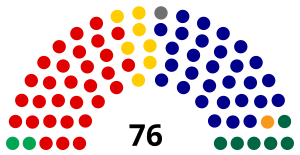1993 Australian federal election
| ||||||||||||||||||||||||||||||||||
All 147 seats in the House of Representatives 74 seats were needed for a majority in the House 40 (of the 76) seats in the Senate | ||||||||||||||||||||||||||||||||||
|---|---|---|---|---|---|---|---|---|---|---|---|---|---|---|---|---|---|---|---|---|---|---|---|---|---|---|---|---|---|---|---|---|---|---|
| ||||||||||||||||||||||||||||||||||
 Popular vote by state and territory with graphs indicating the number of seats won. As this is an IRV election, seat totals are not determined by popular vote by state or territory but instead via results in each electorate. | ||||||||||||||||||||||||||||||||||
| ||||||||||||||||||||||||||||||||||
The 1993 Australian federal election was held to determine the members of the 37th Parliament of Australia. It was held on 13 March 1993. All 147 seats of the Australian House of Representatives and 40 seats of the 76-seat Australian Senate were up for election. The incumbent government of the centre-left Australian Labor Party led by Paul Keating, the Prime Minister of Australia, was re-elected to a fifth term, defeating the centre-right Liberal/National Coalition led by Opposition Leader John Hewson of the Liberal Party of Australia, and coalition partner Tim Fischer of the National Party of Australia. This was the first, and to date only, time the Labor Party won a fifth consecutive election.
The Labor Party under Paul Keating prevailed, against general expectations, and even increased its number of seats in parliament. This was the last time the Labor party would win a federal election until 2007.
It also remains the only time that the Liberal Party was led by a leader, in Hewson, who previously had no experience as a minister.
Background[]

This was the first election after the end of the late 80s/early 90s recession. The opposition Liberal Party was led by John Hewson, a former professor of economics at the University of New South Wales who succeeded Liberal leader Andrew Peacock in 1990. In November 1991 the Liberal Party launched the 650-page Fightback! policy document − a radical collection of "dry", economic liberal measures including the introduction of a goods and services tax (GST), various changes to Medicare including the abolition of bulk billing for non-concession holders, the introduction of a nine-month limit on unemployment benefits, various changes to industrial relations including the abolition of industrial award, a $13 billion personal income tax cut directed at middle and upper income earners, $10 billion in government spending cuts, the abolition of state payroll taxes and the privatisation of a large number of government-owned enterprises. All of this presented a vision of a very different future direction to the Keynesian economic conservatism practiced by previous Liberal/National Coalition governments. The 15 percent GST was the centrepiece of the policy document.
Through 1992, Labor Prime Minister Paul Keating mounted a campaign against the Fightback package, and particularly against the GST. Keating described the GST as an attack on the working class in that it shifted the tax burden from direct taxation of the wealthy to indirect taxation as a broad-based consumption tax. Pressure group activity and public opinion critical of the GST was relentless leading Hewson to exempt food from the proposed GST. However the exclusions announced by Hewson led to questions surrounding the complexity of what precisely which food items would and would not be exempt from the GST. Hewson's difficulty in explaining this to the electorate was exemplified in the infamous birthday cake interview, considered by some as a turning point in the election campaign. Keating won a record fifth consecutive Labor term and a record 13 years in government at the 1993 election, a level of political success not previously seen by federal Labor. A number of the proposals were later adopted in to law in some form, to a small extent during the Keating Labor government, and to a larger extent during the John Howard Liberal government (most famously the GST), while unemployment benefits and bulk billing were re-targeted for a time by the Tony Abbott Liberal government.
The election-eve Newspoll reported the Liberal/National Coalition on a 50.5 percent two-party-preferred vote, with Paul Keating's personal ratings being significantly negative.[1]
For the first time since the 1966 election, an incumbent government had increased their two-party-preferred vote.
There was an unusual circumstance in the division of Dickson. One of the candidates, an independent, died very shortly before the election, making it necessary to hold a supplementary election on 17 April. Following the return of the Labor Party to government, Keating announced the makeup of the Second Keating Ministry to be sworn in on 24 March, but kept the portfolio of Attorney-General of Australia open for Michael Lavarch subject to him winning Dickson on 17 April. He won the seat, and was appointed to the ministry on 27 April.
Aftermath and assessment[]
Keating had run promising a tax cut, but he failed to deliver that promise and was defeated three years later in the 1996 Australian federal election by the Liberal/National Coalition led by John Howard.[2] John Howard would go on to become Australia's second-longest serving Prime Minister.
Speaking in 2019, after Scott Morrison and the Coalition won a shock victory reminiscent of Labor's win in 1993, Hewson was quoted as saying, "In 1993 and 2004, the governments of the day took away the wrong lesson...It was 'we’re invincible!' But the real lesson was 'actually, the people wanted to vote for the opposition, but the opposition scared them off'."[2]
Results[]
House of Representatives results[]

Labor (80)
Opposition (65)
Coalition
Liberal (49)
National (16)
Crossbench (2)
Independent (2)

| Party | Votes | % | Swing | Seats | Change | ||||
|---|---|---|---|---|---|---|---|---|---|
| Labor | 4,751,390 | 44.92 | +5.49 | 80 | +2 | ||||
| Liberal–National coalition | 4,681,822 | 44.27 | +0.81 | 65 | –4 | ||||
| Liberal | 3,888,579 | 36.77 | +2.01 | 49 | –6 | ||||
| National | 758,036 | 7.17 | –1.25 | 16 | +2 | ||||
| Country Liberal | 35,207 | 0.33 | +0.05 | 0 | 0 | ||||
| Democrats | 397,060 | 3.75 | –7.51 | 0 | 0 | ||||
| Greens* | 193,402 | 1.83 | +0.46 | 0 | 0 | ||||
| Natural Law | 78,577 | 0.74 | +0.74 | 0 | 0 | ||||
| Confederate Action | 60,213 | 0.57 | +0.57 | 0 | 0 | ||||
| Call to Australia | 49,467 | 0.47 | –0.50 | 0 | 0 | ||||
| Independent EFF | 9,954 | 0.09 | +0.09 | 0 | 0 | ||||
| Rex Connor Labor | 7,083 | 0.07 | –0.01 | 0 | 0 | ||||
| Citizens Electoral Council | 4,198 | 0.04 | +0.04 | 0 | 0 | ||||
| Indigenous Peoples | 4,069 | 0.04 | +0.04 | 0 | 0 | ||||
| Against Further Immigration | 3,587 | 0.03 | +0.03 | 0 | 0 | ||||
| Grey Power | 1,759 | 0.02 | –0.19 | 0 | 0 | ||||
| Abolish Self Government | 1,663 | 0.02 | +0.02 | 0 | 0 | ||||
| Independents | 332,535 | 3.14 | +0.38 | 2 | +1 | ||||
| Total | 10,576,779 | 147 | –1 | ||||||
| Two-party-preferred vote | |||||||||
| Labor | Win | 51.44 | +1.54 | 80 | +2 | ||||
| Liberal–National coalition | 48.56 | –1.54 | 65 | –4 | |||||
- Note: the federal Australian Greens were founded in 1992, but not all state and territory organisations immediately affiliated to the new federal party. The Greens total includes: Greens New South Wales (46,752), Victorian Greens (3,317), Queensland Greens (58,502), Greens Western Australia (55,907), Greens South Australia (1,496), Tasmanian Greens (24,319), and ACT Green Democratic Alliance (3,109).
- Independents: Ted Mack, Phil Cleary
Senate results[]

Labor (30)
Opposition (36)
Coalition
Liberal (29)
National (6)
CLP (1)
Crossbench (10)
Democrats (7)
Greens (2)
Independent (1)

| Party | Votes | % | Swing | Seats won | Seats held | Change | ||
|---|---|---|---|---|---|---|---|---|
| Labor | 4,643,871 | 43.50 | +5.09 | 17 | 30 | –2 | ||
| Liberal–National coalition | 4,595,148 | 43.05 | +1.13 | 19 | 36 | +2 | ||
| Liberal–National joint ticket | 2,605,157 | 24.40 | –0.07 | 6 | N/A | N/A | ||
| Liberal | 1,664,204 | 15.59 | +1.03 | 11 | 29 | 0 | ||
| National | 290,382 | 2.72 | +0.12 | 1 | 6 | +2 | ||
| Country Liberal | 35,405 | 0.33 | +0.04 | 1 | 1 | 0 | ||
| Democrats | 566,944 | 5.31 | –7.32 | 2 | 7 | –1 | ||
| Greens[a] | 314,845 | 2.95 | +0.85 | 1 | 2 | +1 | ||
| Call to Australia | 108,938 | 1.02 | –0.35 | 0 | 0 | 0 | ||
| Shooters | 63,691 | 0.60 | +0.60 | 0 | 0 | 0 | ||
| Confederate Action | 59,875 | 0.56 | +0.56 | 0 | 0 | 0 | ||
| Against Further Immigration | 46,464 | 0.44 | +0.24 | 0 | 0 | 0 | ||
| Democratic Labor | 38,317 | 0.36 | +0.21 | 0 | 0 | 0 | ||
| Natural Law | 38,054 | 0.36 | +0.36 | 0 | 0 | 0 | ||
| Pensioner and CIR | 22,209 | 0.21 | +0.03 | 0 | 0 | 0 | ||
| Grey Power | 17,595 | 0.16 | –0.11 | 0 | 0 | 0 | ||
| Republican | 15,187 | 0.14 | +0.14 | 0 | 0 | 0 | ||
| Indigenous Peoples | 6,422 | 0.06 | +0.06 | 0 | 0 | 0 | ||
| Independent EFF | 6,031 | 0.06 | –0.58 | 0 | 0 | 0 | ||
| Citizens Electoral Council | 5,578 | 0.05 | –0.02 | 0 | 0 | 0 | ||
| Tasmania | 2,815 | 0.03 | +0.03 | 0 | 0 | 0 | ||
| Abolish Self-Government | 1,708 | 0.02 | +0.02 | 0 | 0 | 0 | ||
| Independent | 184,804 | 1.73 | +1.43 | 1 | 1 | 0 | ||
| Total | 10,674,805 | 40 | 76 | |||||
- Notes
- ^ Several state Green parties had not yet affiliated to the national Australian Greens party (founded in 1992). This total includes 214,117 for the federal Australian Greens, 53,757 votes for the Greens Western Australia, and 46,971 votes for the Green Alliance (in New South Wales).
Seats changing hands[]
| Seat | Pre-1993 | Swing | Post-1993 | ||||||
|---|---|---|---|---|---|---|---|---|---|
| Party | Member | Margin | Margin | Member | Party | ||||
| Adelaide, SA | Labor | Bob Catley | 3.7 | 3.0 | 1.3 | Trish Worth | Liberal | ||
| Bass, Tas | Liberal | Warwick Smith | 4.3 | 4.5 | 0.0 | Silvia Smith | Labor | ||
| Corinella, Vic | Liberal | Russell Broadbent | 0.7 | 4.4 | 3.7 | Alan Griffin | Labor | ||
| Cowan, WA | Labor | Carolyn Jakobsen | 0.9 | 1.8 | 0.9 | Richard Evans | Liberal | ||
| Dunkley, Vic | Liberal | Frank Ford | 1.2 | 1.6 | 0.6 | Bob Chynoweth | Labor | ||
| Franklin, Tas | Liberal | Bruce Goodluck | 2.1 | 9.5 | 7.4 | Harry Quick | Labor | ||
| Gilmore, NSW | National | John Sharp | 4.4 | 1.1 | 0.5 | Peter Knott | Labor | ||
| Grey, SA | Labor | Lloyd O'Neil | 6.5 | 4.3 | 2.1 | Barry Wakelin | Liberal | ||
| Hindmarsh, SA | Labor | John Scott | 5.3 | 2.8 | 1.6 | Chris Gallus | Liberal | ||
| Hinkler, Qld | Labor | Brian Courtice | 4.0 | 4.2 | 0.2 | Paul Neville | National | ||
| Kennedy, Qld | Labor | Rob Hulls | 1.4 | 4.8 | 2.6 | Bob Katter | National | ||
| Lowe, NSW | Liberal | Bob Woods | 0.6 | 4.5 | 5.0 | Mary Easson | Labor | ||
| Lyons, Tas | Liberal | Max Burr | 2.1 | 5.6 | 3.8 | Dick Adams | Labor | ||
| Macquarie, NSW | Liberal | Alasdair Webster | 3.6 | 2.2 | 0.1 | Maggie Deahm | Labor | ||
| McEwen, Vic | Liberal | Fran Bailey | 3.2 | 3.9 | 0.7 | Peter Cleeland | Labor | ||
| McMillan, Vic | Liberal | John Riggall | 4.4 | 4.8 | 0.4 | Barry Cunningham | Labor | ||
| Paterson, NSW | Liberal | notional – new seat | 0.1 | 3.4 | 3.1 | Bob Horne | Labor | ||
| Stirling, WA | Labor | Ron Edwards | 0.1 | 1.7 | 1.5 | Eoin Cameron | Liberal | ||
- Members listed in italics did not contest their seat at this election
See also[]
- Candidates of the Australian federal election, 1993
- Members of the Australian House of Representatives, 1993–1996
- Members of the Australian Senate, 1993–1996
Notes[]
- ^ "Newspoll archive since 1987". Polling.newspoll.com.au.tmp.anchor.net.au. Archived from the original on 3 March 2016. Retrieved 30 July 2016.
- ^ a b Crabb, Annabel (25 May 2019). "Surprise win held a warning for PM. And the first sign of trouble is already here". ABC News. Retrieved 25 May 2019.
References[]
- University of WA election results in Australia since 1890
- AEC 2PP vote
- AustralianPolitics.com election details
- Federal elections in Australia
- 1993 elections in Australia
- Keating Government
- March 1993 events in Australia


